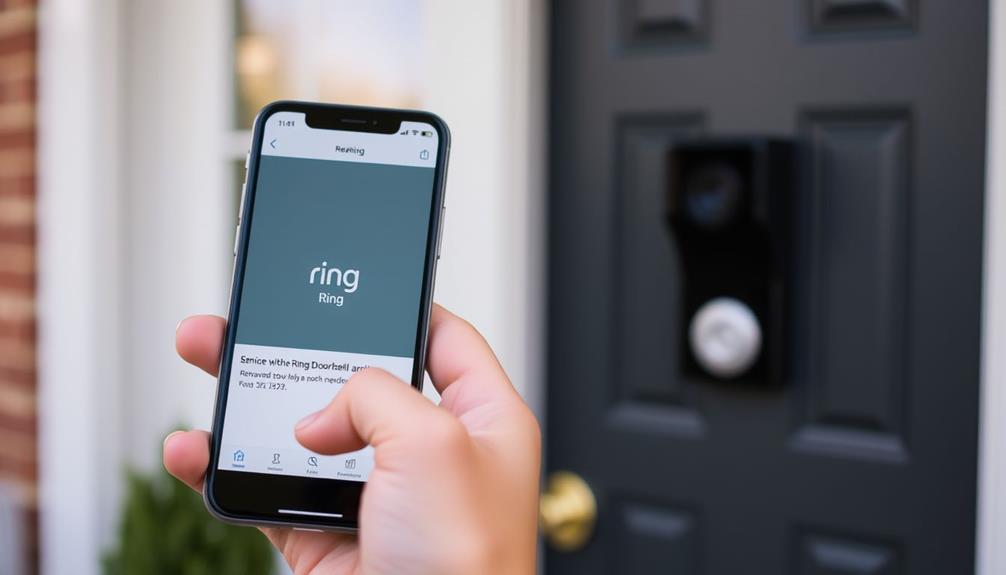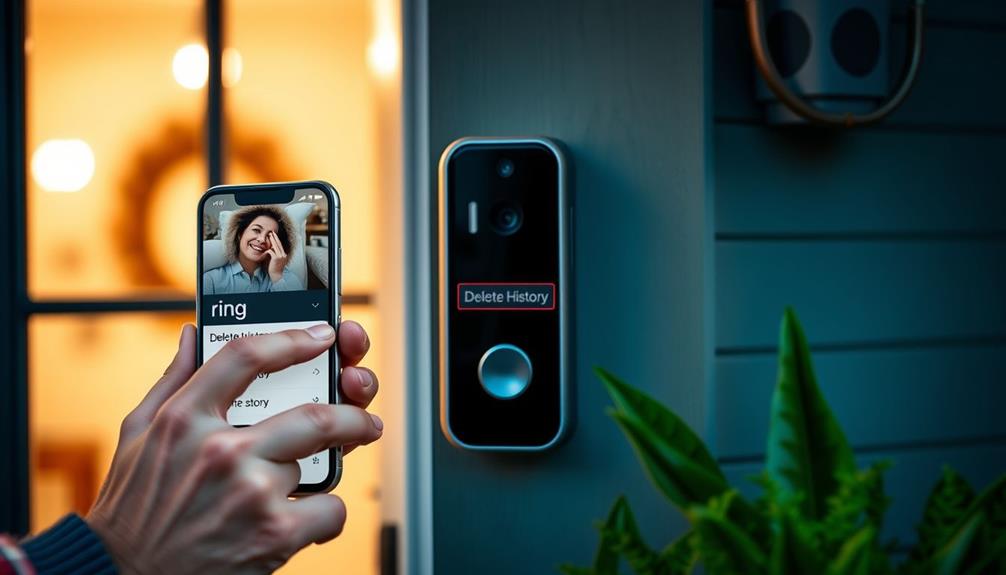To defeat a Ring Doorbell, you need to identify its vulnerabilities. Exploitation techniques include deauthentication attacks, which can disconnect the device from WiFi, or using WiFi scrambling devices that target the 2.4 GHz frequency. Weak passwords and public Wi-Fi increase risks, so always secure your network with strong passwords and consider using a 5 GHz network. Monitoring your network activity can help detect suspicious behavior. Additionally, customizing settings in the Ring app may improve security. By understanding these tactics, you'll strengthen your defenses and keep your home safer. There's more to learn about protecting your device effectively.
Key Takeaways
- Exploit motion sensitivity settings with WiFi scrambling devices to disrupt the Ring doorbell's functionality temporarily.
- Use deauthentication attacks to disconnect the Ring doorbell from WiFi, preventing alerts and recording.
- Employ weak passwords or connect to public Wi-Fi networks to increase the risk of unauthorized access.
- Recognize that many Ring devices operate on 2.4 GHz networks, making them susceptible to signal disruption.
Overview of Ring Doorbell
The Ring Doorbell is a smart home device that combines video surveillance with two-way communication, making it easy for you to monitor and interact with visitors at your front door.
Available in both wired and battery-operated options, Ring doorbells provide flexibility to fit various home setups. Once installed, these devices connect to your WiFi network, allowing you to access live video feeds and recorded footage from your mobile device, no matter where you are. The presence of such security devices can greatly deter potential intruders, as studies show that homes equipped with security systems are less likely to be targeted, enhancing your overall safety and peace of mind value of home security systems.
One of the standout features of Ring doorbells is their motion-activated video recording. With built-in motion alerts, you get notified whenever someone approaches your front door, ensuring you're always aware of activity outside your home.
This capability not only enhances your security but also allows you to respond to visitors in real-time via the two-way talk feature. Whether it's communicating with delivery personnel or greeting friends, you can engage directly without needing to open the door.
Furthermore, Ring products can seamlessly integrate with other Amazon smart home devices, creating a more all-encompassing security system for your home. Together, these features make the Ring Doorbell a powerful tool in modern home security.
Identifying Security Vulnerabilities
To effectively protect your home, you need to recognize the security vulnerabilities in your Ring doorbell.
AI security provides robust defenses against cyber threats, which can help mitigate risks associated with such devices.
Common exploitation techniques, network weaknesses, and user experiences all play an essential role in understanding how these devices can be compromised.
Common Exploitation Techniques
Understanding common exploitation techniques reveals considerable security vulnerabilities in Ring doorbells that can be easily manipulated by thieves.
One major issue is the motion sensitivity settings. Attackers often exploit these features by using WiFi scrambling devices that disrupt the 2.4 GHz signals. This disruption can lead to temporary outages, effectively disabling your Ring doorbell and leaving your property unmonitored. Moreover, the growing reliance on technology in security systems highlights the importance of addressing these vulnerabilities to maintain user safety and trust, as noted in AI advancements raise considerable privacy concerns.
Additionally, the deauthentication technique (commonly known as deauthing) allows cybercriminals to force devices off your WiFi network. When your Ring doorbell disconnects, it can't record or send alerts, creating a perfect window for theft. Many users have reported missing video footage and notifications during such outages, underscoring how these vulnerabilities can have serious consequences.
Unfortunately, WiFi scrambling devices are easily accessible online, making them a popular choice for those looking to exploit security weaknesses. If your WiFi network has weak passwords or you're using public Wi-Fi, the risk of unauthorized access to your Ring device increases greatly.
Network Weaknesses Explored
Exploring network weaknesses reveals essential vulnerabilities that can leave your Ring doorbell exposed to potential attacks. One major risk is the susceptibility to deauthentication (deauthing) attacks, which can disrupt your WiFi connection and allow thieves to bypass your security unnoticed. Many Ring devices operate on 2.4 GHz networks, making them prime targets for easily accessible WiFi scrambling tools.
To better understand these vulnerabilities, here's a table summarizing key issues:
| Vulnerability Type | Impact on Security |
|---|---|
| Deauthentication Attacks | Temporarily severs WiFi connection |
| Weak Passwords | Increases unauthorized access risk |
| Public Wi-Fi Usage | Exposes device to potential breaches |
| Lack of Encryption | Makes data transmission vulnerable |
| 2.4 GHz Network | More susceptible to disruption |
Users have reported missing video footage and notifications during WiFi disruptions, indicating that weak network security can have serious consequences. Although end-to-end encryption has improved protection since 2022, staying vigilant about network vulnerabilities is essential for maintaining the security of your Ring doorbell.
User Experience Insights
User experiences reveal significant security vulnerabilities in Ring doorbells, highlighting the gaps between user expectations and the device's performance during vital moments. Many users have reported missing video footage, raising doubts about the reliability of Ring devices when you need them most. If you rely on your doorbell for security, it's frustrating to find that it sometimes fails to capture essential moments.
In addition, the growing trend of hackathons for innovation emphasizes the need for continuous learning in tech, which can help developers address these vulnerabilities effectively.
Additionally, some users have experienced a lack of notifications for door activity, suggesting potential blind spots in monitoring. When you expect to be alerted to motion but receive no notification, it can leave you feeling exposed.
Compounding these issues is the dissatisfaction with customer service responses, which often fall short during security concerns.
Moreover, reports of thieves using WiFi scrambling devices to disrupt Ring signals reveal a significant vulnerability in the system. These insights from the community emphasize the importance of sharing experiences to foster awareness and implement preventative measures against security risks.
Recognizing these vulnerabilities can help you take steps to enhance your security and confirm your Ring device meets your expectations.
Common User Experiences

Many people have faced frustrating issues with their Ring doorbells, such as missing footage and unreceived notifications about door activity. These problems can undermine your sense of security and leave you feeling vulnerable.
Additionally, as technology advances, users often compare their experiences with other security solutions, including those that offer enhanced audio experiences like home theater setups.
Here are some common experiences that resonate with users:
- Anxiety over missed incidents: You can't trust your security device if it fails to record important moments.
- Disappointment in notifications: When you're expecting alerts and get nothing, it's disheartening.
- Frustration with customer service: When you seek help, only to be met with unresponsive support, it adds to the stress.
- Feeling exposed: Knowing that your Ring device mightn't capture everything can make you feel unsafe in your own home.
These experiences highlight the pressing need for better performance and reliability in Ring devices.
As you navigate these challenges, it's crucial to stay informed and proactive in protecting your home.
Technical Insights on Hacking
When you understand the risks associated with WiFi scrambling devices, you can see how they disrupt your Ring doorbell's signal, opening the door for theft.
The need for strong problem-solving skills can help you address these vulnerabilities proactively, ensuring more robust security measures are in place.
Additionally, implementing a methodical approach to your home network can greatly minimize these risks and enhance overall safety, as highlighted in best practices in software quality assurance.
The deauthentication attack is another method that forces your device offline, leaving it vulnerable during the outage.
This emphasizes the need for layered security to protect against such technical threats.
WiFi Scrambling Device Risks
WiFi scrambling devices pose a significant threat to the security of Ring doorbells by disrupting their essential 2.4 GHz signals, leaving them vulnerable to brief outages. These disruptions typically last between 1-2 minutes, creating a window for thieves to act without triggering security alerts.
If you're relying on your Ring doorbell for safety, you need to understand these risks, as AI security provides robust defenses against such vulnerabilities.
- Imagine a thief lurking outside, knowing exactly when your security system is down.
- Picture your home being invaded while you think you're protected.
- Feel the anxiety of a sudden, unexpected silence when your doorbell fails.
- Consider the frustration of losing your peace of mind due to a simple gadget.
While Ring devices that support 5 GHz networks are harder to disrupt, many users still rely on the common 2.4 GHz frequency.
To enhance your security against WiFi scrambling devices, consider implementing layered measures like using 5 GHz networks and strong passwords.
Awareness and proactive steps can make a significant difference in your home's safety.
Deauthentication Attack Explained
A deauthentication attack, commonly known as "deauthing," targets your WiFi network by sending deauthentication packets to disconnect devices like your Ring doorbell temporarily.
This technique typically disrupts WiFi signals for about 1-2 minutes, creating a window for intruders to operate unnoticed.
Since many smart doorbells, including the Ring products, often rely on 2.4 GHz networks, they become prime targets for these attacks.
Effective use of social media platforms can help spread awareness about these security risks, enhancing community vigilance and proactive measures.
Thieves can easily acquire WiFi scrambling devices online, which facilitate the execution of deauthentication attacks against unsuspecting users.
During the disconnection, your smart doorbell may fail to record important events or notifications, leaving your home vulnerable.
To counter this risk, consider switching to a 5 GHz network for your Ring devices.
This frequency is less commonly used for smart home devices and is harder to disrupt compared to 2.4 GHz networks.
By making this change, you can enhance your security and make it more challenging for an attacker to utilize a deauthentication attack against your WiFi network.
Taking proactive steps will help safeguard your smart doorbells and protect your home from potential intrusions.
Layered Security Importance
Layered security measures are essential for protecting your Ring devices against various hacking methods, including deauthentication attacks. By implementing a multi-faceted approach, you can greatly bolster your defenses, ensuring that your Ring account remains secure and your Ring motion alerts are reliable.
Additionally, understanding the importance of a balanced digital environment can help enhance your overall security posture. Incorporating hydration strategies to optimize metabolism during the climb can metaphorically relate to maintaining a healthy digital ecosystem where your devices communicate effectively without interference.
- Protect your privacy—don't let hackers invade your home.
- Keep your family safe—intimidate intruders with strong security.
- Gain peace of mind—enjoy knowing your home is monitored.
- Avoid costly breaches—prevent financial loss from theft or data leaks.
Start by using both 2.4 GHz and 5 GHz networks to reduce the risk of Wi-Fi scrambling attacks. Implement strong, complex passwords and enable two-factor authentication (2FA) to safeguard your Ring account.
Regularly update your Ring software and app to benefit from the latest security patches. Utilize a separate guest Wi-Fi network for your smart devices to limit exposure, and make it a habit to delete old footage, decreasing sensitive data available if a breach occurs.
Community Support and Solutions

Engaging with community discussions can greatly enhance your understanding of how to secure your Ring doorbell against potential vulnerabilities. By participating in these conversations, you can share experiences and learn about the latest security risks that others have encountered.
This collective knowledge can help you find an answer to pressing concerns regarding your device, particularly as credit card debt in the U.S. surpassed $930 billion in 2020, highlighting the importance of financial security in our lives.
Users often log into their Ring accounts to access personalized support and troubleshooting resources. These platforms frequently highlight user-recommended solutions and preventative actions that can considerably reduce risks associated with Ring doorbell vulnerabilities.
You'll discover effective methods for enhancing your security, such as employing layered security measures.
Additionally, community forums provide insights into potential hacking attempts and signal disruptions. The shared experiences of other users can inform your approach and empower you to take proactive steps in securing your device.
The more you engage with these discussions, the better equipped you'll be to implement effective strategies that protect your home.
Disabling Ring Doorbell Features
Disabling certain features of your Ring doorbell allows you to customize its functionality according to your preferences and needs. You can easily manage motion alerts and recordings through the Ring app, giving you greater control over your home security experience.
Additionally, maintaining good indoor air quality with tools like ozone air purifiers can enhance your overall home environment, making it a more comfortable space to live in.
- Quiet evenings without constant notifications
- Peace of mind during family gatherings
- Tailored security for your unique schedule
- Reduced anxiety from unnecessary alerts
In the Motion settings of the Ring app, you can adjust the motion sensitivity slider to limit alerts or even schedule specific times to disable them completely.
If you want to turn off motion recording, simply navigate to your device's settings in the app and disable that feature. This allows you to maintain a level of security without being overwhelmed by notifications.
If you need a break from alerts, you can temporarily mute notifications while still accessing past recordings. Disabling these features doesn't diminish your Ring doorbell's functionality; it merely helps you tailor its performance to fit your lifestyle better.
Preventing Unauthorized Access

To keep your Ring doorbell secure from unauthorized access, start by setting up a guest Wi-Fi network with a unique password. This isolates your Ring device from other devices on your primary network, greatly reducing the risk of intrusions.
When you create your Ring account, make sure to use a strong, complex password. Enabling two-factor authentication (2FA) adds another layer of security, protecting against unauthorized logins.
Regularly update your Ring device and app to guarantee you have the latest security patches, safeguarding your system against known vulnerabilities. Additionally, consider installing a firewall and antivirus software on your home network to further defend against potential breaches that could target your wired Ring setup.
It's also wise to periodically delete old footage from your Ring account. This minimizes the amount of accessible data in the event of a security breach, protecting your privacy.
Frequently Asked Questions
How Do Burglars Disable Ring Doorbell?
Burglars can disable your Ring doorbell by using WiFi scrambling devices, which disrupt its connection.
They often employ deauthentication techniques that cause brief dropouts in the WiFi signal, lasting 1-2 minutes, allowing them to act unnoticed.
This can lead to missing footage and no notifications during vital moments.
Being aware of these tactics is essential for you to enhance your home security and protect your property effectively.
Is There a Device to Block a Ring Doorbell?
Yes, there are devices designed to block a Ring doorbell.
These WiFi scrambling devices can disrupt the signal, especially on 2.4 GHz networks, using a technique called deauthentication.
However, if your Ring supports 5 GHz, it's tougher to block.
To enhance your security, you should use strong passwords and enable two-factor authentication.
Staying aware of these vulnerabilities helps you take proactive measures to safeguard your device from potential disruptions.
Can I Block My Neighbor's Ring Doorbell?
Imagine a fortress guarding your privacy, yet your neighbor's Ring doorbell feels like an ever-watchful eye. You might wonder if you can block it, but tampering with someone else's device isn't just risky—it could land you in hot water legally.
Instead, consider enhancing your own security measures. Open up a dialogue with your neighbor about privacy concerns; communication often builds stronger walls than any technical trick could ever achieve.
Can Someone Stop a Ring Doorbell From Recording?
Yes, someone can stop a Ring doorbell from recording.
They might use WiFi scrambling devices to disrupt its connection, effectively preventing it from capturing video during vital moments. This technique can last for 1-2 minutes, leaving your doorbell blind to what's happening.
To enhance your security, consider using a separate guest Wi-Fi network and adjusting device settings, which could help reduce the risk of your Ring doorbell being disabled.
Conclusion
In a world where security feels paramount, can you really afford to overlook the vulnerabilities of your Ring Doorbell?
With the right knowledge, you can safeguard your home against potential threats lurking just outside your door. Whether it’s securing entry points or monitoring activity around the perimeter, a selfmonitoring home security system can provide peace of mind by allowing you to keep an eye on your property remotely. These systems offer real-time alerts directly to your smartphone, allowing you to respond quickly to any suspicious activity. Best of all, they give you control without the need for expensive professional monitoring services.
Imagine the peace of mind you'll gain by understanding how to fortify your system.
Don't wait until it's too late—dive deeper into the intricacies of your device, and take control before someone else does.
Your security is in your hands.









